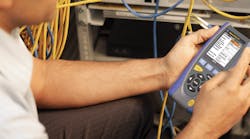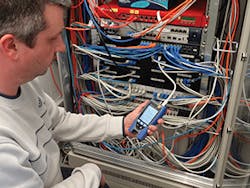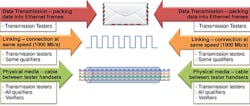The Right Way to Get an A+ in Choosing Cable and Network Test Equipment
Many cable and network testing products can seem similar at first glance, and, with an increasing number of testers available, it can be difficult to know which tester is the best option for the job. Selecting the right equipment equates to very real benefits to productivity, efficiency, cash flow, and cost savings, so it is essential to consider which options are the best fit before any investment.
To select the correct tester, it’s important to understand the basics of network infrastructure and layers, as well as the differences between types of testers.
Network Infrastructure 101
There are 2 distinct categories within network infrastructure:
Category 1. Passive cabling refers to cable permanently installed. Some examples of systems with passive cabling are CCTV, access control, A/V, alarms, and data/voice systems. Generic or structured cabling, which supports a number of systems and applications, is also in the category. Passive cabling also includes the patch panels and outlets terminated at each end, connection (consolidation) points installed in a horizontal link, and the equipment and patch cords used to connect the cabling to active equipment.
Category 2. Active equipment in a network can be generic or proprietary, depending on the application. However, as most information systems using passive cabling rely on Ethernet/IP as the foundation for data transmission, testers can often be used across a wide range of applications. This provides benefits in keeping costs down, and also helps technicians on a practical level, minimising the amount of equipment that needs to be transported to jobs.
Having understood the basics of network infrastructure, next it is important to ascertain which layers of an Ethernet/IP network the equipment will need to operate on.
Learning About Layers
All Ethernet/IP systems are divided into layers defined by the Open Systems Interconnection (OSI) model which separates the processes of transmitting data across a network into several layers. The majority of cable installers and IT Technicians need to troubleshoot issues that occur with Layers 1 to 3.
Layer 1: Physical Layer
This layer includes electrical/optical signalling and physical cabling components that connect devices on the network. For example:
• Horizontal and backbone cabling, both copper and fibre optic.
• Wi-Fi and other wireless signals (considered physical).
• Hubs and repeaters.
• Copper and fibre optic network interface ports (PHY) on network devices (or "nodes"), such as PCs, switches, routers, IP cameras and wireless access points.
• Media converters, which are devices that convert electrical signals to optical or radio frequency and vice versa.
Layer 2: Data Link Layer
This layer provides data transfer between 2 directly connected nodes (network devices) or 2 nodes on the same network. This layer:
• Detects and corrects physical layer problems (e.g., automatic crossover switching between 2 Ethernet switches when a crossover cable is not used).
• Controls the physical addressing of devices on the network so every Ethernet device in the world has a unique Media Access Control (MAC) address.
• Encodes and decodes data frames, adds a source and destination MAC address to each frame.
• Performs error checking and discards bad data frames transmitted on Layer 1.
• Synchronises devices with systems such as auto-negotiation between 10/100/1000 Mb/s devices.
Layer 3: Network Layer
The final layer provides data transfer between nodes on different networks, it:
• Encapsulates Layer 2 frames inside of a data packet.
• Adds source and destination IP address to each data packet.
• Assigns an IP address that is unique to each node on its own network.
Choosing Your Tester
Each layer uses different testers for different purposes, so to select the right tester, it must be established what is being tested for and what results/data is needed.
Verifier: For the lowest cost way to test electrical continuity of the cabling between 2 points, check for shorts, opens, crossed and split pairs on Layer 1, you should choose a verifier. More than 80% of all network problems can be traced back to a physical cabling fault — which a verifier can simply detect — so every cabling technician should carry a tester, which acts as a verifier to test every link after it is terminated. Some verifiers have added diagnostic and troubleshooting functions, like measuring cable length and distance to fault, cable tracing with audible tone generation or visual port blinking, Ethernet service detection and PoE testing, which may mean that an additional tester isn’t required.
Certifier: A cable certifier also works on Layer 1 but uses radio frequencies on the cabling to measure performance to international ISO and TIA standards, providing a pass or fail result, ensuring that the cabling can support a wide range of applications. This makes a certifier the right choice for technicians or installers that work on jobs where a cable manufacturer warranty is required.
Certifiers can require a larger financial investment, but some models have other useful functionality, such as the ability to work on both copper and fiber cabling, troubleshooting, plus options to export a wider range of data and reports.
Qualifier: A qualifier does not test the cable in Layer 1 as such, but is useful for conducting simulations to test whether the cable can successfully transmit data from point to point.
If technicians require cable manufacturer warranties, or a project specifically requires (TIA/ISO) certification, then a cable certifier must be used as a qualifier does not perform the measurements required to prove the cabling meets the required standards.
To prove that cabling infrastructure meets the customer’s bandwidth requirements, a qualifier would also not be sufficient, and a Layer 2 transmission tester is needed.
Transmission Tester: These testers exist for both Layer 2 and Layer 3. For measuring the successful transmission of data across a cable or through a network, a Layer 2 data transmission tester is needed.
Data transmission testers for Layer 2 generate Ethernet frames that simulate network data which traverses network cabling, and can even be sent through Ethernet switches. The testers generate Ethernet frames with a MAC address that can be read and directed by network switches. The result of the transmission test is a data loss ratio expressed as a percentage of total frames successfully transmitted or the number of dropped frames. Many Layer 2 transmission testers also incorporate the functionality of a qualifier.
Layer 3 testers offer similar functionality to Layer 2 testers except that they generate an IP packet that encapsulates the Ethernet frame. This packet carries an IP address that can be read by Layer 3 switches and network routers allowing a Layer 3 packet to traverse different networks or different subnets on a single network (e.g., testing the data transmission between the wired and wireless portions of a LAN or testing between different buildings of a large campus-sized network). As a Layer 3 transmission tester generates complete packets with IP addresses, it can also be used to test Wide Area Networks (WANs) to measure bandwidth between different locations across the Internet.
Layer 3 testers are usually chosen only by network owners/managers and system integrators, as there is a need to be familiar with network addressing and subnets to properly configure the tester. (See Figure 1.)
Figure 1. Different functions of testers across network layers.
If you still are unsure which type of tester to select, IDEAL Networks’ online Product Finder can assess the features, applications or cable connections you require, and advise which tester will be the right choice for you. Visit https://www.idealnetworks.net/UK/EN/Product-Finder.aspx#
[toggle title=”6 Questions to Ask Before You Test” load=”hide”]1. What functionality is needed?
Which layer/s the tester needs to work on, and the type of data and test results required (e.g., Is a cable manufacturer warranty needed?).
2. Where will it be used?
For outdoor use, a suitably robust model is required. Or, for working in small spaces, a tester that does not require a bulky laptop for exporting test results may be preferred.
3. What is your budget?
Budget is more than purchase price. It should also include costs for ongoing support and maintenance; tester might come with an expensive support contract.
4. What are the product’s maintenance needs?
If testers will be on the road, then technicians and installers may need to conduct basic repairs and replacements. Is this possible, quick, and easy to do on your chosen tester?
5. Does the tool require training to use?
Without much time or budget for training, a tester that is intuitive to use is a must for getting technicians up and running quickly.
6. How does this interact with other equipment that is currently used?
Different testers in use may mean various software or methods are required to export, analyse, and report results. Consider the time and cost implications, and whether it would pay dividends to have complementary equipment in the fleet.[/toggle]
Save
Save
Save







